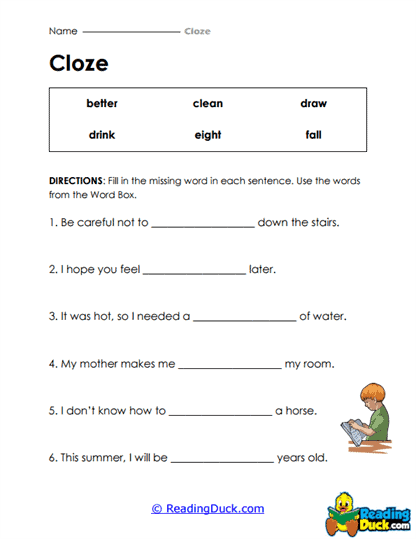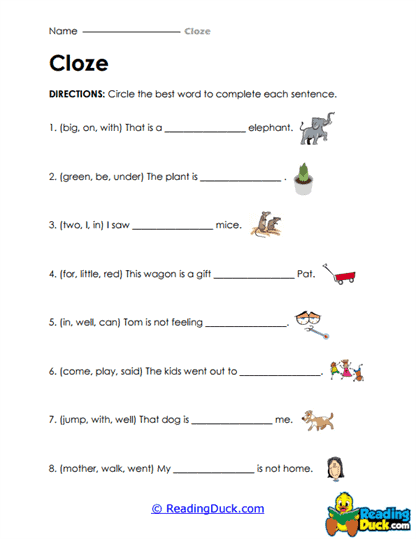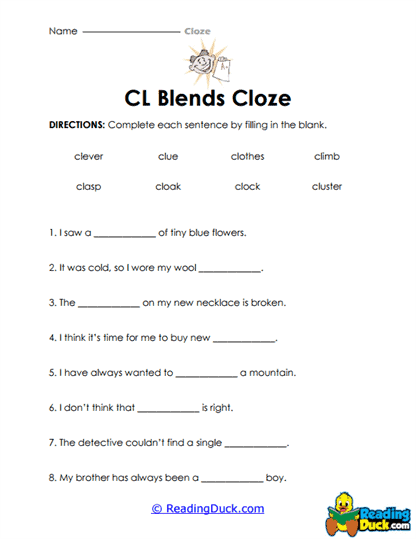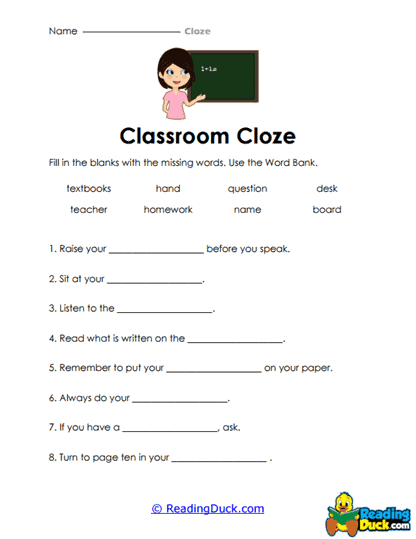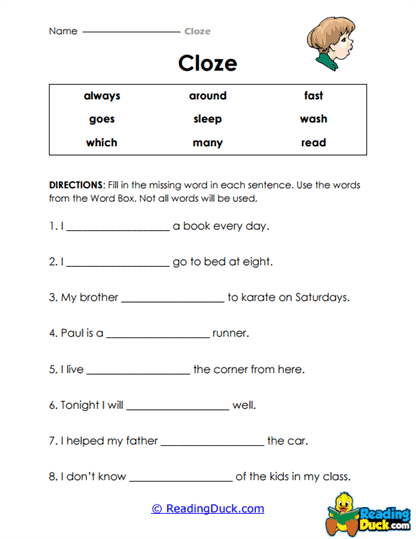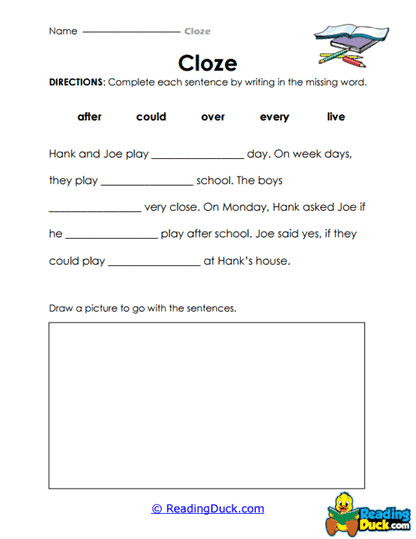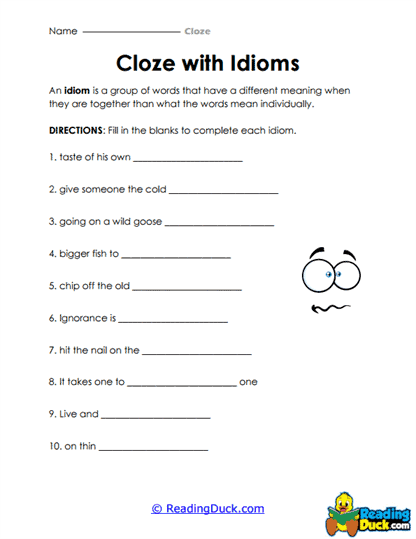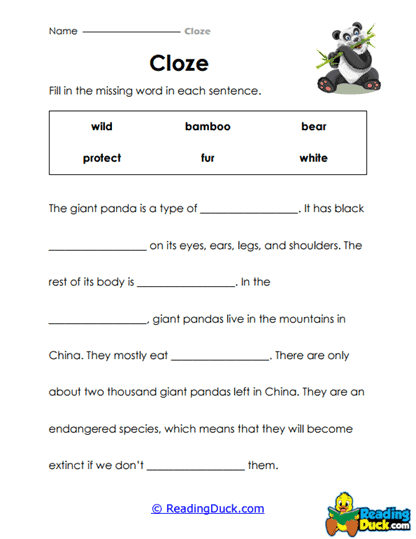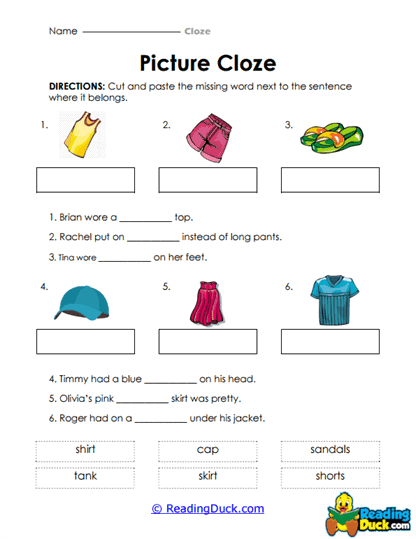Cloze Worksheets
About Our Cloze Worksheets
Our collection of Cloze Worksheets offers a powerful tool for helping students strengthen their language and writing skills. These worksheets focus on improving reading comprehension, vocabulary, and grammar through the interactive cloze technique, where students fill in blanks within a passage using appropriate words or phrases. This hands-on approach not only reinforces vocabulary and contextual understanding but also encourages critical thinking as students assess the structure and meaning of the text.
Presented in PDF format, these worksheets are easy to view, download, and print, making them convenient for teachers, parents, and students alike. Each worksheet is accompanied by a downloadable answer key, providing a straightforward way to check answers and offer feedback. Whether used in the classroom or for independent study, these worksheets deliver engaging, effective practice that can be adapted for learners at various levels.
The Power of Cloze in Language Learning
Cloze exercises are a dynamic and interactive method for developing essential writing and reading skills. In these activities, students encounter passages with key words omitted, requiring them to fill in the blanks with contextually appropriate choices. This format challenges students to think critically, using their understanding of language structure, vocabulary, and context clues to determine the correct responses.
Cloze activities are especially beneficial because they simulate real-world reading experiences, where readers must often infer meaning or recall specific vocabulary based on context. These exercises promote active engagement with the text, helping students:
- Enhance vocabulary retention by using familiar and new words in context.
- Develop grammar skills by choosing words that fit syntactically and semantically.
- Strengthen reading comprehension by requiring students to fully understand a passage in order to complete it accurately.
Cloze worksheets also allow for flexible implementation. They can be tailored to various text types, including narrative, informational, and persuasive writing, providing a comprehensive approach to language development.
Building Key Writing and Critical Thinking Skills
Our Cloze Worksheets are designed not only to improve language comprehension but also to foster critical thinking and writing skills. Students must actively engage with the text, making thoughtful decisions about word choices while considering the overall meaning of the passage. This deep interaction with the text helps them:
- Enhance their ability to infer meaning from context.
- Improve grammar and syntax awareness, as students must select words that fit both the meaning and structure of the sentence.
- Develop stronger sentence fluency by recognizing how word choices affect the flow and coherence of a passage.
For example, a cloze worksheet might feature a narrative text with missing descriptive words. Students must use their knowledge of vocabulary and context to fill in the blanks, strengthening their ability to construct cohesive and compelling stories. Similarly, in an informational text, students might focus on using domain-specific vocabulary to accurately complete a passage, which reinforces subject-matter understanding while boosting language skills.
These worksheets also help improve students' ability to engage in metacognitive thinking—considering not only what word fits but also why that word is the best choice. This kind of critical reflection supports broader writing and analytical abilities.
Fostering Creativity and Adaptability in Learning
One of the key advantages of cloze worksheets is how they encourage creativity and critical thought. The process of filling in blanks requires students to think imaginatively, exploring different possible word choices that can change or enhance the meaning of the passage. These exercises push students to move beyond surface-level reading, encouraging them to interact with the text on a deeper level.
Our Cloze Worksheets can be adapted to suit students with varying abilities and learning paces. Teachers can easily modify the difficulty level by selecting passages that match their students’ current reading level or by adjusting the complexity of the missing words. For younger or less advanced students, cloze exercises might focus on simpler vocabulary, while older or more advanced learners can tackle more complex passages and nuanced vocabulary. This adaptability ensures that students remain challenged and engaged at an appropriate level for their learning needs.
These worksheets can also serve as differentiated instruction tools, making them ideal for mixed-ability classrooms. Teachers can assign different worksheets based on students’ skills, ensuring that each learner receives targeted practice without feeling overwhelmed.
Integrating Cloze Worksheets into Broader Learning Units
Cloze worksheets are versatile resources that can be seamlessly incorporated into larger classroom projects and units. By building a foundation of vocabulary and comprehension skills, these worksheets can prepare students for more advanced assignments such as essay writing, literary analysis, or presentations.
Ways to Integrate Cloze Worksheets:
- Essay Writing Preparation: Use cloze exercises focused on transition words, topic sentences, or supporting details to help students prepare for structured essay writing. These worksheets can introduce key terms and phrases that improve their writing flow and coherence.
- Literary Analysis: Incorporate cloze passages from literary texts to reinforce students' understanding of key themes, characters, or narrative techniques. After completing a cloze worksheet, students can engage in discussions or written reflections that delve deeper into the meaning and structure of the text.
- Group Projects or Presentations: Cloze worksheets can serve as collaborative tools for group work, where students must work together to complete a passage and discuss the reasoning behind their word choices. This fosters both language skills and teamwork.
By embedding these worksheets within broader learning objectives, teachers can ensure students are practicing essential writing skills while working toward larger, more complex tasks.
Engaging Students Through Interactive Learning
Our Cloze Worksheets offer a level of engagement that keeps students motivated and actively involved in the learning process. The interactive nature of filling in blanks creates a more engaging experience than passive reading exercises, encouraging students to think carefully about their choices.
Why Cloze Worksheets Engage Learners:
- Interactive and Thought-Provoking: Cloze exercises require students to engage with the material in a hands-on way, promoting active learning and deeper understanding.
- Motivating for Independent Study: These worksheets are also ideal for self-paced learning. Students can complete them on their own and use the answer key to check their work, allowing them to see immediate progress and improvement.
- Applicable Across Subjects: Cloze worksheets can be adapted for use in a variety of subjects, from language arts to science and social studies, helping students see the relevance of these skills across different disciplines.
In addition to being engaging, cloze exercises help students become more aware of their own language abilities, fostering a sense of achievement as they successfully complete each worksheet.
Complementary Activities to Reinforce Cloze Skills
To further reinforce the skills practiced in our Cloze Worksheets, teachers can integrate complementary activities that provide additional context and application opportunities. These activities promote collaboration, creativity, and deeper comprehension.
Suggested Complementary Activities:
- Group Discussions: After completing a cloze worksheet, students can discuss their word choices and explore how different selections change the meaning of the passage.
- Context Clue Challenges: Pair cloze worksheets with activities where students deduce the meaning of unfamiliar words by examining the surrounding text, helping them develop stronger inference skills.
- Creative Writing Extensions: After completing a cloze worksheet, ask students to write their own version of the passage or extend it, allowing them to apply the vocabulary and context skills they've learned.
- Subject-Specific Projects: In history or science, use cloze passages that relate to key concepts, then have students create presentations or reports where they expand on the ideas introduced in the worksheet.
These complementary activities not only reinforce the skills developed in the worksheets but also keep students actively engaged and motivated to learn.
Grade-Level Recommendations and Adaptability
Cloze worksheets are a valuable resource across various grade levels, as they can be easily tailored to suit the age and ability of the students.
Ideal Grade Levels:
- Elementary (Grades 3-5): Focus on basic vocabulary and sentence structure with simpler texts.
- Middle School (Grades 6-8): Introduce more complex passages, including narrative and informational texts, to build vocabulary and comprehension.
- High School (Grades 9-12): Challenge students with advanced texts and nuanced vocabulary, preparing them for essay writing and literary analysis.
Teachers can adjust the difficulty level by modifying the types of words omitted and the complexity of the text, ensuring that every student can participate meaningfully, regardless of their current proficiency.
Promoting Real-World Learning Through Cloze Worksheets
Our Cloze Worksheets support project-based learning by giving students the skills to succeed in real-world writing tasks. The ability to accurately interpret and use vocabulary in context is essential for many academic and professional situations.
For instance, completing cloze worksheets in evaluating arguments could help students prepare for debates, while cloze passages focused on comparing different literary genres could evolve into creative writing and performance assignments. These exercises encourage students to apply their learning in collaborative, practical ways, fostering a deeper understanding of the material and promoting teamwork.
By incorporating these dynamic, adaptable worksheets into your teaching plan, students will develop critical thinking, reading comprehension, and writing skills, all while remaining engaged and motivated to learn.
